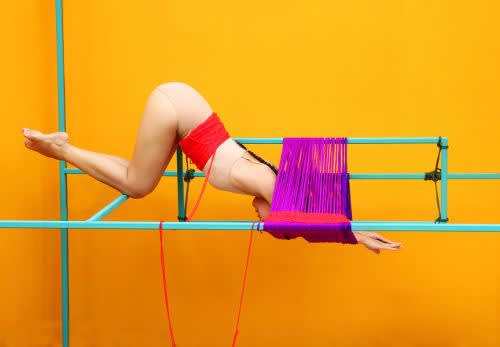PERFORMING TEXTILES
KAWITA VATANAJYANKUR
Web review by Robyn Maree Pickens
DUNEDIN PUBLIC ART GALLERY
“Performing Textiles” at the Dunedin Public Art Gallery—the first exhibition by Thai artist Kawita Vatanajyankur in New Zealand—was at once a continuation of Vatanajyankur’s investigation on the subject of labor, and a specific engagement with New Zealand’s dominant textile industry: wool. Resulting from six weeks of on-the-ground research in Aotearoa in late 2017, three of the four performance-videos in the exhibition directly embody stages of the wool-processing industry: dyeing, spinning and weaving. By “embody,” I mean Vatanajyankur uses her body as an instrument. Or, more precisely, Vatanajyankur meditates and practices her way into being the tool or process she performs.
Vatanajyankur constructs human-size structures, such as looms, which she then becomes a part of. For example, in the video Shuttle (2018), an aqua-colored metal structure supports a purple skein of fiber across its arms. Vatanajyankur launches herself through the narrow gap between the threads and slips through to the other side. She wears a pale apricot leotard with bright red strands of wool encircling her lower torso, which unwind behind her and then cross the purple fibers. As the title Shuttle suggests, Vatanajyankur is herself the shuttle, who produces, with each dive through the warp and weft, another line of a woven textile. Her moves are carefully choreographed, and she practiced for weeks or months in advance of filming, as the sequences she performs are physically demanding, frequently tugging at the limits of endurance. Vatanajyankur draws on the positive effects of meditation, such as enhanced focus, to assist her stamina and, importantly, to channel her abilities to become, in this instance, the shuttle.
Whether a shuttle as in this work, or a textile bobbin in The Spinning Wheel (2018)—the only two-channel video work in “Performing Textiles”—Vatanajyankur’s facial expression remains composed, if not serene. Such composure throughout sustained exertions amplifies the absurdity of her iterative actions, and serves to bolster her ongoing parody of working life. Indeed, Vatanajyankur’s critique tackles both the unpaid or lowly paid manual labor carried out by women in Thailand (whether domestic or employed), and that of any working person, regardless of income bracket, intent on shoring up wealth. It is the skewed field of capitalism that is Vatanajyankur’s ultimate target. This is evident not only in the absurd and frequently abject contortions that Vatanajyankur subjects her body to, but also in the hyper-colored backdrops and painted structures she utilizes. Vatanajyankur’s Day-Glo palette mimics the attention-grabbing packaging and advertising of hyper-consumerism. She invokes the strident visual language of capitalism via détournement, and though her absurd, repetitive actions are interpreted as being critical of the system, the artist recognizes that such a critique is positioned from within the capitalist world—the fact that the actions she performs may not derail capitalist mechanisms only adds to a sense of absurdity.
An exaggeratedly sugary color palette is also seen in Dye (2018). The work was the first to greet visitors to the exhibition, and features Vatanajyankur suspended above a bowl of brilliant red dye that is surrounded by a tangle of orange-hued wool fibers. In the video, Vatanajyankur, against an eggshell-blue background, is herself an implement, a vehicle for the Medusa-like sprawl of threads attached to her head. Her ankles are bound and she is suspended headfirst over the large bowl of dye for a full 7 minutes and 42 seconds. For much of the time, Vatanajyankur holds her breath underwater in an attempt to dye the white wool attached to her head red. In addition to her bound ankles, Vatanajyankur wears her trademark pale apricot leotard, and a pair of hands clasp either side of her hips to guide her in this intentionally absurd and repetitive procedure. Vatanajyankur grips her handler’s wrists. Arguably, Dye is the work in the exhibition that most explicitly addresses the gendered, frequently sexualized nature of labor. Many of the generative tensions in Vatanajyankur’s work are evident in Dye: submission and strength, abjection and hyper-color, absurdity and performative intention. The artist is at once subjugated and resilient, and the female laborer vulnerable and powerful within the larger warp of hyper-capitalism.
Kawita Vatanajyankur’s “Performing Textiles” is on view at Dunedin Public Art Gallery until August 26, 2018.


